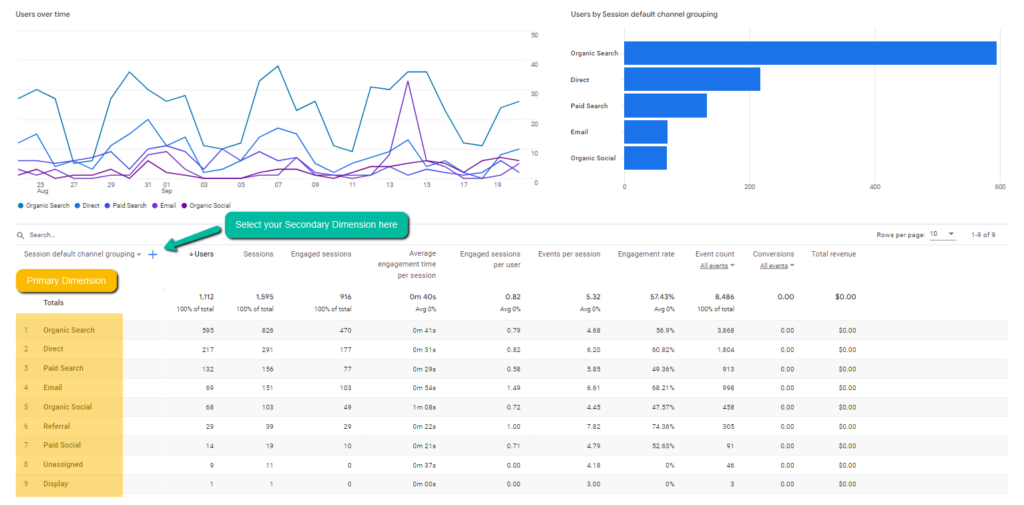Improving Data Precision: Google Analytics Secondary Dimension Insights
Improving Data Precision: Google Analytics Secondary Dimension Insights
Blog Article
Opening the Power of Secondary Dimension Analytics for Enhanced Information Insights and Decision-Making
In the world of information analytics, primary measurements typically take the limelight, but the real depth of understandings exists within the world of second measurements. These added information points supply a nuanced viewpoint that can light up patterns and relationships not readily noticeable initially glance. By using the power of second measurement analytics, organizations can reveal concealed fads, discover relationships, and extract extra meaningful final thoughts from their data. The possibility for improved decision-making via the utilization of these additional dimensions is substantial, guaranteeing a deeper understanding of intricate information sets and leading the way for even more informed strategic selections.
Importance of Secondary Measurements
Exploring the value of second measurements in analytics reveals the hidden layers of data understandings critical for notified decision-making in numerous domain names. Additional dimensions provide a deeper understanding of key information by offering additional context and point of views. By including additional measurements right into analytics, companies can remove a lot more comprehensive and nuanced understandings from their datasets.
One secret significance of second dimensions is their capacity to sector and categorize key information, permitting an extra detailed analysis of specific parts within a dataset. This division allows services to identify patterns, fads, and outliers that could not appear when taking a look at the data all at once. In addition, additional measurements assist in revealing connections and dependences between various variables, bring about more exact forecasting and anticipating modeling.
In addition, secondary measurements play a crucial duty in improving information visualization and coverage. By adding secondary dimensions to visualizations, such as graphes or charts, experts can produce extra helpful and informative depictions of information, assisting in much better interaction of searchings for to stakeholders. Overall, the assimilation of additional dimensions in analytics contributes in unlocking the full potential of information and driving evidence-based decision-making.
Secret Advantages of Making Use Of Additional Measurements
Utilizing secondary dimensions in analytics offers companies a tactical advantage by augmenting the depth and granularity of information insights. By exploring data utilizing secondary dimensions such as time, location, tool type, or user demographics, organizations can discover patterns, fads, and connections that might or else continue to be hidden.
Additionally, the utilization of second measurements improves the context in which key data is translated. It gives a much more comprehensive sight of the connections between different variables, enabling organizations to make educated decisions based on a much more alternative understanding of their data. Furthermore, secondary measurements facilitate the recognition of outliers, anomalies, and locations for optimization, ultimately leading to more effective strategies and enhanced end results. By leveraging additional measurements in analytics, organizations can harness the complete potential of their information to drive better decision-making and attain their company objectives.
Advanced Data Evaluation Strategies
A deep study advanced data evaluation strategies discloses innovative techniques for drawing out useful insights from complex datasets. One such technique is equipment learning, where algorithms are used to determine patterns within information, forecast end results, and make data-driven choices. This technique enables the automation of logical model building, making it possible for the processing of large volumes of data at a quicker rate than conventional approaches.
Another advanced technique is anticipating analytics, which uses statistical formulas and artificial intelligence strategies to anticipate future end results based upon historic data. By assessing fads and patterns, businesses can anticipate client actions, market patterns, and prospective risks, equipping them to make proactive choices.
Additionally, message mining and view analysis are valuable techniques for removing understandings from unstructured information resources such as social media remarks, consumer evaluations, and study reactions. By examining text data, organizations can recognize customer viewpoints, determine arising fads, and improve their product and services based upon feedback.
Enhancing Decision-Making Through Secondary Dimensions

Enhancing decision-making via second measurements makes it possible for companies to make more notified and targeted tactical explanation options. For instance, by segmenting client information based on second measurements like buying history or involvement degrees, business can tailor their marketing strategies to certain audience segments, causing enhanced conversion rates and client complete satisfaction. Additional measurements can aid identify relationships and connections in between various variables, making it possible for organizations to make data-driven decisions that drive growth and productivity.
Implementing Second Dimension Analytics
When including additional dimensions in analytics, companies can open much deeper understandings that drive calculated decision-making and enhance general performance. Applying secondary dimension analytics requires an organized approach to make certain effective utilization of this powerful tool. The primary step is to determine the vital metrics and dimensions that line up with the company's critical goals. This entails comprehending the specific questions the company looks for to address and the information points called for to address them.

Additionally, companies should take advantage of progressed analytics devices and modern technologies to streamline the process of incorporating secondary measurements. These devices can automate information processing, evaluation, and visualization, permitting companies to concentrate on translating understandings instead of hands-on information adjustment.
Verdict
In conclusion, second measurement analytics play a vital function in boosting information understandings and decision-making processes. By using sophisticated information analysis techniques and executing secondary measurements properly, companies can unlock the power of their information to drive calculated organization choices.
In the realm of data analytics, primary measurements often take the limelight, but the true depth of insights lies within the world of second measurements.Utilizing secondary measurements in analytics offers companies a critical advantage by boosting the depth and granularity of information insights. By leveraging second measurements in analytics, companies can harness the complete capacity of their data to drive better decision-making and attain their business objectives.
Executing data recognition procedures and normal audits can help maintain information top quality and dependability.
By utilizing innovative information evaluation methods and executing second dimensions efficiently, organizations can open the power of their data to drive critical company choices.
Report this page